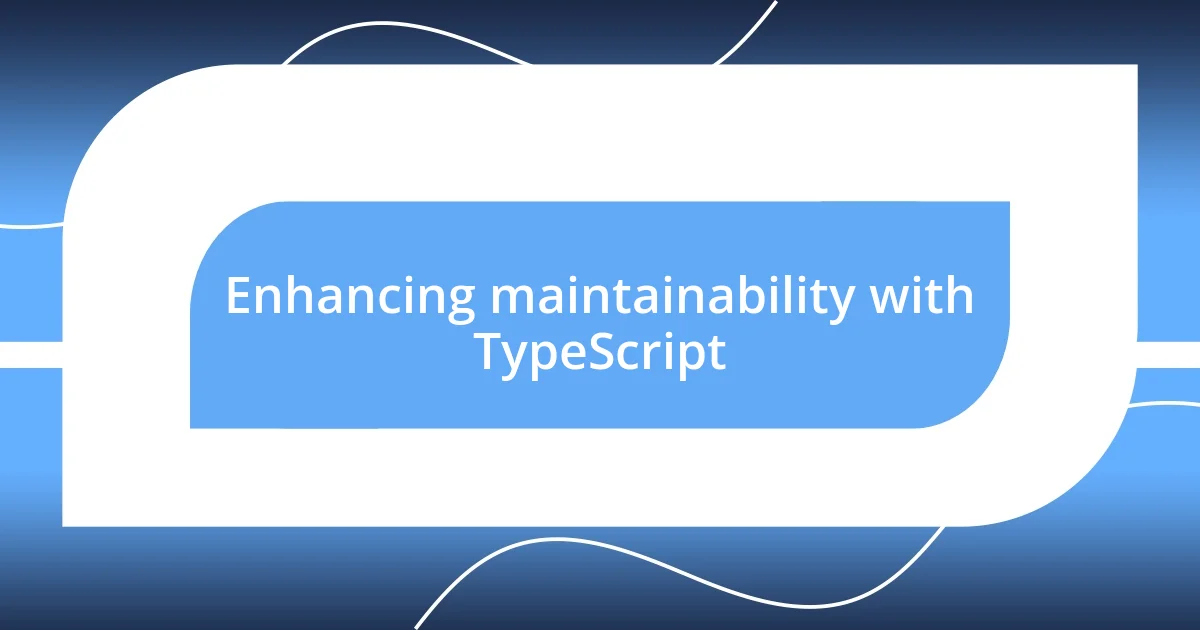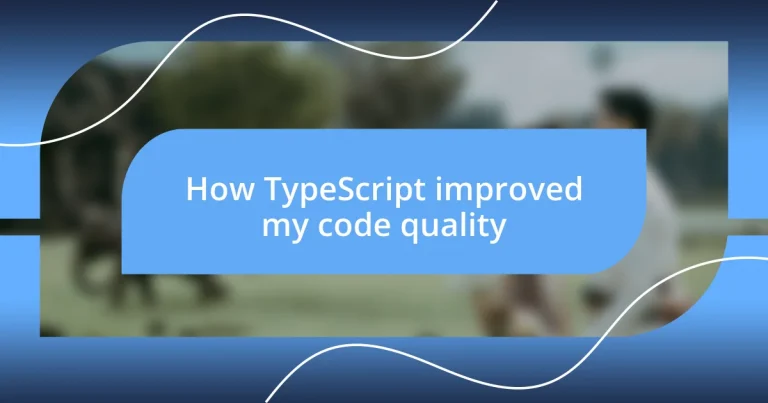Key takeaways:
- TypeScript’s static typing significantly reduces runtime errors and enhances coding confidence, allowing for a smoother development experience.
- Integrating TypeScript improves code readability and maintains collaborative efficiency, as explicit type definitions foster clearer communication among team members.
- Gradual adoption of TypeScript, along with leveraging its features like automatic type inference, leads to safer code refactoring and better overall project maintainability.

Understanding TypeScript benefits
One of the standout benefits of TypeScript is its static typing system. When I first started using it, I felt an immediate relief from the chaos of runtime errors. I remember a specific project where I had a complex data structure; with TypeScript, I could define types that guided me through the coding process. This not only improved my confidence but also minimized dreaded debugging sessions later on. Isn’t it comforting to feel that safety net while coding?
Another remarkable aspect is TypeScript’s enhanced autocompletion feature. I was genuinely amazed at how much more productive I became with intelligent code suggestions. It’s like having a reliable coding buddy beside you. For instance, while working on a large codebase, I found that I could quickly navigate various functions. How often have you struggled to remember what a function did? TypeScript makes that much easier, allowing you to focus on solving problems rather than recalling every detail.
Furthermore, TypeScript facilitates collaboration within teams. I’ve had experiences where misunderstandings in variable types led to needless confusion among teammates. With TypeScript, the interface and type definitions serve as a clear communication tool. It feels rewarding to know that we can all be on the same page, reducing friction and allowing ideas to flow more freely. Do you see how this can transform the team dynamic?

Transitioning from JavaScript to TypeScript
Transitioning from JavaScript to TypeScript can seem daunting at first, but I found it to be a refreshing change. When I first started, there was a bit of a learning curve, particularly with understanding how to properly define types. I remember sitting in front of my screen, unsure how to make sense of the documentation. However, once I embraced the notion of types, everything clicked. The clarity and structure it brought to my projects were worth the initial struggle.
- Understanding types: Defining specific types helps catch potential errors early.
- Gradual adoption: I slowly converted parts of my project to TypeScript rather than a complete overhaul, which eased the transition.
- Mental shift: I had to train myself to think about my data structures differently, enhancing my problem-solving skills.
Moving to TypeScript has reshaped not only how I code but also how I approach programming problems. Initially, I felt somewhat lost, constantly referring back to TypeScript’s documentation. Yet, with each new feature I learned to use, I became increasingly fascinated by its capabilities. I vividly recall a moment when I successfully refactored a large chunk of legacy code, and the satisfaction of knowing it was type-safe was unparalleled. That breakthrough was like a light bulb moment.

Improving code readability with TypeScript
When I started working with TypeScript, one of the most noticeable improvements was the overall readability of my code. I still remember the first time I used interfaces to define the shape of an object. It felt like providing a map for future developers (including my future self) navigating through the code. In a way, it was like giving explicit labels to sections of a library, making it effortlessly clear where to find what you need.
As I delved deeper, I appreciated how TypeScript’s type annotations serve not just as documentation but as part of the code. With every function I wrote, I could see the input types and return types laid out clearly. This level of transparency made it so much easier to understand the flow of data. Have you ever faced a scenario where deciphering someone else’s code felt like decoding a locked treasure chest? TypeScript helps eliminate that guesswork with its straightforward structure, making code reviews quicker and more productive.
Moreover, collaborating with others became a breeze. I recall a project where different developers contributed snippets that often missed type definitions, leading to confusion. But with TypeScript in play, we all utilized the same standards, leading to cleaner and more consistent code. It was empowering to see how our collective understanding of TypeScript transformed our communication and efficiency.
| Without TypeScript | With TypeScript |
|---|---|
| Implicit type definitions | Explicit type annotations |
| Code lacks documentation | Self-documenting code |
| Increased guesswork | Reduced ambiguity |
| Confusing variable names | Clear interfaces and types |

Leveraging types for better safety
Leveraging types in TypeScript has profoundly impacted my coding experience by enhancing safety at every turn. For instance, I distinctly recall a situation where I was working on a complex function that computed user statistics. Initially, I neglected to specify types for the function parameters, which led to an unexpected runtime error. After embracing TypeScript’s type system, I made it a point to declare types from the start. The result? A dramatic reduction in bugs, transforming my coding sessions from frantic troubleshooting into a smoother, more enjoyable flow. Doesn’t that sound appealing?
What I particularly value about using explicit types is the heightened sense of security it provides. It almost feels like having a safety net beneath me as I navigate through developing features. I often think back to my early days with JavaScript, where I relied heavily on intuition. With TypeScript, I remember a moment when a subtle type mismatch was highlighted by my IDE, saving me from a potential headache down the line. It was a small, but powerful reminder of why those types matter so much.
Moreover, I find that defining types fosters a more thoughtful approach to coding. When I sit down to write a new function, I pause to consider the kinds of data it will process, rather than diving in headfirst. This reflective process has nudged me to write cleaner and more efficient code. Have you ever felt that thrill from crafting a function that not only works but feels intuitive? That’s the beauty of leveraging types—each piece of code becomes a well-defined part of the larger puzzle, fostering an environment of safety and clarity.

Enhancing maintainability with TypeScript
When working on larger projects, maintaining code can sometimes feel like trying to tame a wild beast. I remember diving into a particularly old codebase where the lack of type structure was maddening. It was difficult to know how changes would affect functionality and often led to unintended consequences. TypeScript has completely transformed this experience for me—I now approach even the most intricate systems with confidence, knowing that the strong typing and defined interfaces act as reliable guides.
One of my favorite aspects of TypeScript is how it encourages me to think ahead. For instance, while working on a module for managing user settings, I found myself deliberately considering all possible states of the data. This proactive mindset not only improved the code but also made future modifications much simpler. Have you ever had moments where you realized that your foresight could prevent headaches later on? With TypeScript, I find that planning and organization become second nature, leading to fewer surprises down the road.
As I embraced TypeScript more, I also noticed a shift in my team’s workflow. During a recent collaboration, we were able to onboard new developers more seamlessly. Thanks to clear type definitions, they could understand and contribute to the codebase right away. I can’t highlight enough how reassuring this consistency is; it creates a shared language amongst us. Isn’t it refreshing to know that everyone is on the same page, minimizing the time spent in discussions about what something is supposed to do? This collective clarity has significantly enhanced our maintainability, making it feel almost effortless.

Integrating TypeScript into existing projects
Integrating TypeScript into existing projects can feel like a daunting task, especially when you’re staring down a tangled web of legacy code. I remember my own experience with an old JavaScript application that seemed immune to change. The first step I took was to gradually introduce TypeScript into the codebase, starting with a single module. By adding type annotations little by little, I noticed immediate benefits: my code reviews became more of a constructive dialogue instead of a frantic search for hidden pitfalls.
One trick that worked wonders for me was utilizing TypeScript’s automatic type inference. As I incorporated TypeScript, I was surprised by how much of the type information was inferred as I wrote. It felt like riding a bicycle for the first time—initially wobbly but soon a natural extension of my coding style. The safety net of types allowed me to refactor existing code without the persistent fear of breaking something along the way. Have you ever felt that rush of adrenaline when making significant changes to a codebase, coupled with the fear of unseen consequences? With TypeScript, that feeling transformed into quiet confidence.
As I expanded TypeScript’s reach within the project, I found that it significantly improved communication within my team. Whenever we approached a new feature, instead of vague discussions about what data types we expected, we relied on well-defined interfaces. I can vividly recall a sprint planning session where one of my colleagues said, “Having those type definitions makes it so much clearer how our components fit together.” That moment encapsulated the magic of TypeScript—it brought structure to our chaos, transforming what once felt like abstract concepts into tangible, actionable plans. Isn’t it amazing how a few well-placed types can shift the dynamics of collaboration?














